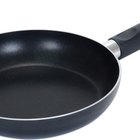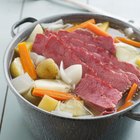marceloferreiro/iStock/GettyImages
Pot roast was once a staple of Sunday family dinners, but as red meat – and family dinners -- fell out of favor, fewer new cooks learn to master this classic dish. Pot roast done incorrectly can be stringy and dry, but when browned thoroughly and allowed to simmer for hours, it becomes a succulent and tender treat. Vinegar contains acids which help to tenderize the meat, giving even the newest cook a head start on turning out a perfect pot roast every time.
Rinse your pot roast thoroughly and pat it dry with paper towels. This refreshes the meat, especially if it has been sitting in its own juices for longer than overnight. A chuck roast is the traditional cut for pot roast, and 4 pounds is a good size to start with.
Season the roast on all sides with a generous amount of salt and pepper. The salt draws all of the moisture in the cells of the meat to the surface, helping to form a thin, crisp crust. As the meat cooks, the salt and the water sinks back through the muscle fibers, tenderizing them and adding flavor. Pepper adds flavor, while cracked pepper adds texture.
Coat the bottom of a Dutch oven or heavy skillet with oil. Canola or vegetable oil works, but olive oil adds flavor to the meat. Add seasonings such as rosemary, thyme, garlic and onion if you like.
Heat the oil over medium-high heat until it shimmers. Brown the pot roast on all sides. Don’t just sear it; let the crust turn a deep, dark brown. This caramelization is called the Maillard effect and it adds flavor as well as texture.
Leave the browned roast in the Dutch oven, or move it to a deep pot, roaster or slow cooker if you browned it in a skillet.
Add enough vinegar to the pot roast to just cover its bottom and maybe 1/4 inch of the sides. The amount doesn’t have to be exact, but about a cup of liquid for a 4-pound roast is about right. You can use any type of vinegar including white, sherry or flavored vinegar like raspberry, but the milder and deeper flavor of balsamic vinegar works especially well. If you prefer a less tangy result, mix the vinegar with water, broth or wine.
Cover the pot and cook the roast for 3 to 4 hours at a mild simmer or in a preheated 300-degree-Fahrenheit oven, 4 hours in a slow cooker on high or 8 hours in a slow cooker on low. The pot roast is done when an instant-read thermometer reads at least 145 F. Remove the pot roast from the heat and let it rest for at least 10 minutes before serving.
Related Articles

How to Make a Blackbuck Antelope Roast

How to Cook Beef Top Round Pot Roast
How to Cook Venison So it Doesn't Get ...

How to Use Vinegar to Cook Pot Roast

How to Make a Tender and Juicy Pot Roast

How to Make a Black Pepper Crust on a ...

How to Marinate a Top Round Roast

How to Make Marinade for Roast Beef
How to Cook Buffalo Fillet

How to Make a Juicy Pork Tenderloin

How Long to Cook a Rump Roast for It to ...
How to Slow Cook a Pot Roast With Beef ...

How to Marinate a Pork Shoulder

How to Cook a Deer Neck Roast in a Slow ...

How to Convection Roast a Brisket

How to Slow Cook a Joint of Beef

How to Cook a 15-Pound Rib Roast
How to Cook Brisket Slowly With a ...

How to Cook Knuckle Roast
How to Cook a Choice Chuck Roast
References
Tips
- Coat the roast in seasoned flour before browning it for a thicker, richer crust.
- Fry roughly chopped bacon in the oil before browning the roast for an extra layer of flavor.
Warnings
- Do not allow pot roast to overcook because it will lose flavor as well as becoming tough and dry.
Writer Bio
Brynne Chandler raised three children alone while travelling, remodeling old homes, taking classes at the Unioversity of California Northridge and enjoying a successful career writing TV Animation. Her passions include cooking, tinkering, decorating and muscle cars. Brynne has been writing fun and informative non-fiction articles for almost a decade. She is hard at work on her first cookbook, which combines healthy eating with science-based natural remedies.